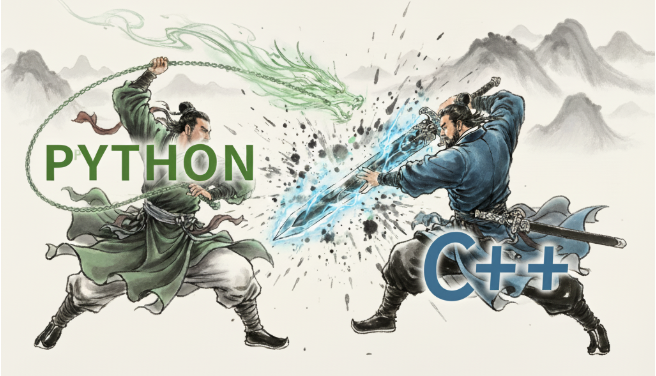引言
某些刷题系统超时时间卡得很严格,同一道题目,相同算法,用 python 写就会超时,用 C++ 写就能AC。
这不仅引发进一步思考:C++ 是不是绝对比 python 快,究竟快多少?

实验测试
有人说 C++ 比 Python快几十倍,有人说快上百倍,不如直接来进行实验测试。
1. 简单计算场景
任务:计算从 1 到 N 的所有整数的平方和
N 取值为100万:
python代码:
python
import time
def sum_of_squares(n):
total = 0
for i in range(1, n + 1):
total += i * i
return total
if __name__ == "__main__":
N = 1000000
start = time.time()
result = sum_of_squares(N)
end = time.time()
print("Result:", result)
print("Time (Python):", end - start, "seconds")C++代码:
c
#include <iostream>
#include <chrono>
using namespace std;
long long sum_of_squares(int n) {
long long total = 0;
for (int i = 1; i <= n; i++) {
total += 1LL * i * i;
}
return total;
}
int main() {
int N = 1000000;
auto start = chrono::high_resolution_clock::now();
long long result = sum_of_squares(N);
auto end = chrono::high_resolution_clock::now();
chrono::duration<double> elapsed = end - start;
cout << "Result: " << result << endl;
cout << "Time (C++): " << elapsed.count() << " seconds" << endl;
return 0;
}运行时间:
bash
Time (Python): 0.06529355049133301 seconds
Time (C++): 0.0010278 secondsC++ 的速度约是 python 的 65 倍。
如果 N 取值为 1000万:
输出时间:
bash
Time (C++): 0.0167507 seconds
Time (Python): 0.6048719882965088 secondsC++ 的速度约是 python 的 36 倍。
2. 包含IO场景的测试
写一个包含100万条的信息的日志文件。
python代码
python
import time
def generate_log_file(filename, n):
with open(filename, "w") as f:
for i in range(n):
f.write(f"[INFO] line {i}: this is a test log message\n")
if __name__ == "__main__":
N = 1000000
filename = "log_python.txt"
start = time.perf_counter()
generate_log_file(filename, N)
end = time.perf_counter()
print(f"Generated {N} lines into {filename}")
print("Time (Python):", end - start, "seconds")C++代码
cpp
#include <iostream>
#include <fstream>
#include <chrono>
using namespace std;
void generate_log_file(const string &filename, int n) {
ofstream fout(filename);
for (int i = 0; i < n; i++) {
fout << "[INFO] line " << i << ": this is a test log message\n";
}
fout.close();
}
int main() {
int N = 1000000;
string filename = "log_cpp.txt";
auto start = chrono::high_resolution_clock::now();
generate_log_file(filename, N);
auto end = chrono::high_resolution_clock::now();
chrono::duration<double> elapsed = end - start;
cout << "Generated " << N << " lines into " << filename << endl;
cout << "Time (C++): " << elapsed.count() << " seconds" << endl;
return 0;
}结果
Time (Python): 0.6496610003523529 seconds
Time (C++): 0.442306 seconds受到磁盘写入速度的限制,在 IO 场景下,C++ 的速度仅为是 python 的 1.46 倍。
3. 矩阵密集计算
下面再测试一个矩阵相乘的计算场景。
python代码,测试普通循环和使用numpy两种方式。
python
import time
import random
import numpy as np
N = 300 # 矩阵大小
# 用 Python 列表生成矩阵
A = [[random.random() for _ in range(N)] for _ in range(N)]
B = [[random.random() for _ in range(N)] for _ in range(N)]
# ---------- Python 三重循环 ----------
start = time.perf_counter()
C = [[0.0] * N for _ in range(N)]
for i in range(N):
for j in range(N):
s = 0.0
for k in range(N):
s += A[i][k] * B[k][j]
C[i][j] = s
end = time.perf_counter()
print(f"Time (Python triple loop): {end - start:.6f} seconds")
# ---------- NumPy 实现 ----------
A_np = np.array(A)
B_np = np.array(B)
start = time.perf_counter()
C_np = np.dot(A_np, B_np)
end = time.perf_counter()
print(f"Time (NumPy): {end - start:.6f} seconds")C++代码,测试普通循环、使用Eigen和使用BLAS三种方式:
cpp
#include <iostream>
#include <vector>
#include <cstdlib>
#include <ctime>
#include <cmath>
#include <Eigen/Dense>
#include <cblas.h>
using namespace std;
using namespace Eigen;
// ================= 原生 C++ 三重循环 =================
void naiveMultiply(const vector<vector<double>>& A,
const vector<vector<double>>& B,
vector<vector<double>>& C, int N) {
for (int i = 0; i < N; i++) {
for (int j = 0; j < N; j++) {
double s = 0.0;
for (int k = 0; k < N; k++) {
s += A[i][k] * B[k][j];
}
C[i][j] = s;
}
}
}
// ================= 结果验证 =================
bool checkResult(const MatrixXd& C1, const MatrixXd& C2, double tol = 1e-8) {
if (C1.rows() != C2.rows() || C1.cols() != C2.cols()) return false;
for (int i = 0; i < C1.rows(); i++) {
for (int j = 0; j < C1.cols(); j++) {
if (fabs(C1(i,j) - C2(i,j)) > tol) return false;
}
}
return true;
}
int main() {
int N = 300; // 矩阵大小
// 随机数初始化
srand(time(0));
// ====== 生成矩阵 ======
vector<vector<double>> A(N, vector<double>(N));
vector<vector<double>> B(N, vector<double>(N));
vector<vector<double>> C(N, vector<double>(N, 0.0));
for (int i = 0; i < N; i++) {
for (int j = 0; j < N; j++) {
A[i][j] = rand() / (double)RAND_MAX;
B[i][j] = rand() / (double)RAND_MAX;
}
}
// ====== Naive C++ ======
clock_t start = clock();
naiveMultiply(A, B, C, N);
clock_t end = clock();
cout << "Time (Naive C++): " << (double)(end - start) / CLOCKS_PER_SEC << " seconds\n";
// 转成 Eigen 矩阵
MatrixXd EA(N, N), EB(N, N), EC(N, N);
for (int i = 0; i < N; i++) {
for (int j = 0; j < N; j++) {
EA(i, j) = A[i][j];
EB(i, j) = B[i][j];
}
}
// ====== Eigen ======
start = clock();
EC = EA * EB;
end = clock();
cout << "Time (Eigen): " << (double)(end - start) / CLOCKS_PER_SEC << " seconds\n";
// ====== BLAS (cblas_dgemm) ======
vector<double> A1D(N * N), B1D(N * N), C1D(N * N, 0.0);
// 转换为列主序 (BLAS 默认列主序)
for (int i = 0; i < N; i++) {
for (int j = 0; j < N; j++) {
A1D[j * N + i] = A[i][j];
B1D[j * N + i] = B[i][j];
}
}
start = clock();
cblas_dgemm(CblasColMajor, CblasNoTrans, CblasNoTrans,
N, N, N, 1.0,
A1D.data(), N,
B1D.data(), N,
0.0,
C1D.data(), N);
end = clock();
cout << "Time (BLAS dgemm): " << (double)(end - start) / CLOCKS_PER_SEC << " seconds\n";
return 0;
}结果:
Time (Python triple loop): 3.641190 seconds
Time (NumPy): 0.000746 seconds
Time (Naive C++): 0.206 seconds
Time (Eigen): 0.224 seconds
Time (BLAS dgemm): 0.001 seconds普通模式情况下,C++的速度确实比python快,但python使用NumPy之后,速度可以接近C++使用BLAS ,C++的Eigen库并不能带来加速效果,可能和操作系统有关,测试所用的操作系统为win10。
总结
一般情况下,C++ 确实比 Python 会快很多,在普通计算效率上,至少有10倍以上的提升,主要原因是语言本身的差异性:
- C++ 是编译型语言,源代码会被编译为机器码,直接在 CPU 上运行,几乎没有额外的解释开销。
- Python 是解释型语言,运行时需要解释器逐行执行代码,每一步操作都要经过额外的对象管理和动态类型检查,计算效率天然落后。
但是,当任务涉及文件写入、磁盘读写或网络通信 时,性能瓶颈转移到操作系统和硬件的 IO 延迟上,两者的速度差异会减小。
此外,Python在借 助NumPy 等第三库之后,计算效率反而比未经优化的C++速度更快,主要原因是 Numpy 的矩阵乘法核心调用了底层 C/Fortran 的 BLAS/LAPACK 库,这些库经过几十年的优化,包含一系列优化策略:
- 循环展开、SIMD 向量化(利用 SSE/AVX 指令集,一次处理多个数据);
- Cache 优化(分块算法 block matrix multiplication,减少 cache miss);
- 多线程并行(OpenBLAS/MKL 可以利用多核 CPU 并行计算);
- 硬件加速(在某些场景下甚至能利用 GPU)。
因此,直接认为 C++ 比 Python 快是不准确的,C++ 的优化空间会比 Python 更多,但需要的操作会更繁琐。在比较运行效率时,需要考虑测试场景和代码质量。